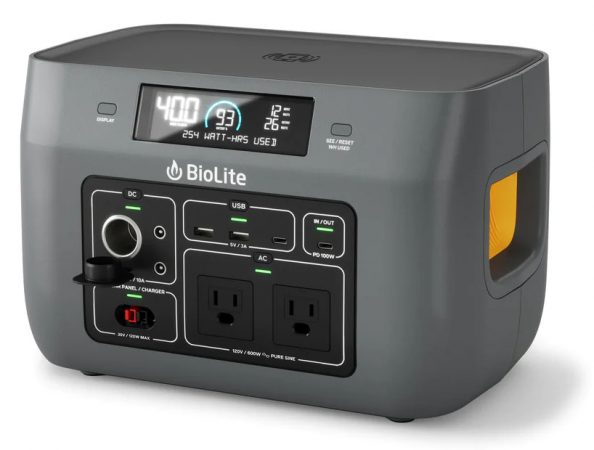
A few of our favorite portable power stations out at camp. Photo: Steve Andrews//The Inertia
Off-the-grid ain’t what it used to be. But that’s okay, roughing it is overrated. That’s why we love portable power stations: glorified batteries that can bring all the comforts of home to a campsite or allow for remote work in extremely remote places. Portable power is booming, and it’s a great time to check out the awesome options on the market.
This year, we tested a wide array of portable power stations to electrify off-grid adventures without needing to lug around gasoline and a noisy generator. The following guide is the result of our findings over hundreds of hours of charging and powering all kinds of devices far away from civilized society.
Navigate To: Comparison Table | How We Tested | Buyer’s Guide
Related: Best Car Camping Gear | Best Camping Gear for Couples | More Camping Gear
Editor’s Note: We updated this guide in December 2025 with two new picks (the DJI Power 2000 and Anker SOLIX F3800 Plus), updated links, and improved formatting.
The Best Portable Power Stations of 2025
Best Overall Portable Power Station: EcoFlow River 2 Pro
Best Value Portable Power Station: Bluetti AC70
Runner-Up Best Power Station: DJI Power 2000
Best Power Station for Home Backup: Anker SOLIX F3800 Plus
Best Portable Power Bank: Anker 737
Best Compact Power Station for Camping: EcoFlow River 3
Best Overall Portable Power Station
EcoFlow River 2 Pro ($549)
Models Available (Wh): 256, 512, 768 (River series), 2400, 3600 (Delta series)
Model Tested: River 2 Pro (768 Wh)
Charge Time: 70 Min
Capacity: 768Wh
Output: 800W
Ports: 4 AC, 3 USB-A, 1 USB-C
Weight: 17 lbs
Pros: Super fast charging time (70 min), 4 AC and 4 USB ports
Cons: Extended handle makes for wasted space
EcoFlow has quickly established itself as a leader in portable power stations with its impressive lineup of offerings. The River series is the more portable class of power stations under 1000 Wh, and the Delta series offers some great large-scale options. With excellent stackability, the EcoFlow line would be best for those needing to transport and store many units at once. The River 2 Pro had the fastest charging time of all the units tested at a screaming 70 minutes, so it’s an ideal option when needing a good portable unit that can be ready to go in a jiffy. It also has the most ports in its class, with 4 AC, 3 USB-A, and a 100W USB-C.
For the best combination of available ports, charging time, portability, and ability to stack, we couldn’t find much wrong with the EcoFlow River 2 Pro. We felt that, while the build quality might be slightly better from Goal Zero and Jackery, those brands couldn’t compete with the output for the price of the River 2 Pro. Unless you need something truly massive (like the Delta 2 Max model), we found the 768Wh capacity with 800W max output to be a real sweet spot between the common 500Wh and 1000Wh units. It provided the portability of smaller options with nearly the same output as larger power stations.
Overall, the combination of output ports, capacity, and portability made the EcoFlow River 2 Pro our top pick portable power station.
Check Price on REI Check price on Amazon
Best Value Portable Power Station
Bluetti AC70 ($399)
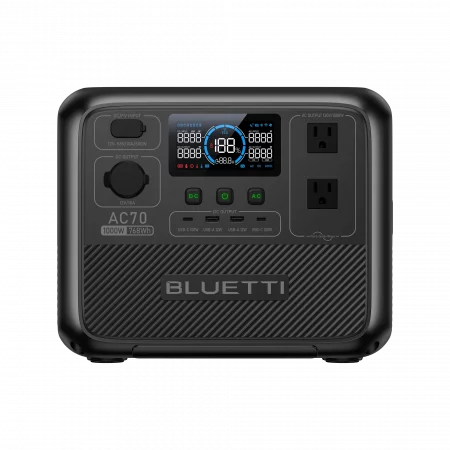 Models Available (in Wh): 204, 403, 768, 1,152, 2,043
Models Available (in Wh): 204, 403, 768, 1,152, 2,043
Models Tested: AC70 (768 Wh), AC2A (204Wh)
Charge Time: 70 min to 80%
Output: 1,000 W (2,000W peak)
Ports: Input: AC, Solar, 12V Output: 2x USB-A, 2X USB-C, 2x AC, DC
Weight: 22.5 lbs
Pros: Clear display, fast charging time
Cons: Fan is on the louder side
Bluetti makes power stations of all shapes and sizes, from the ultra-portable AC2A to the massive AC200P. They are all a part of their AC series, which provides ultra-fast AC charging of up to 950 watts, meaning anything below that in Watt-hours can be charged in less than an hour. The system does seem to run a bit hot when maxed out on AC power, so noise is an issue, but only when it’s running at full bore.
The rest of the time, the Bluetti AC70 offers an easy-to-read display that lets you know just how much power is coming in and out. The AC70 is a 768Wh unit, which was the best output-for-the-price that we tested. Plus, with a 2,000W peak power output, you can run other items such as kitchen appliances for a short period with no worries. While it doesn’t have the port options or ease of use that the EcoFlow does, this Bluetti power station packs a ton of performance at this price point.
Check price on Amazon Check price on Bluetti
Runner-Up Best Power Station
DJI Power 2000 ($1099)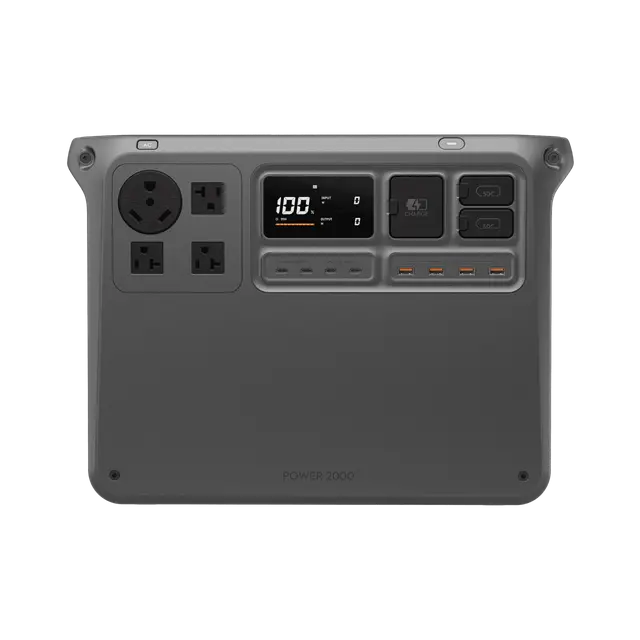
Models Available (in Wh): 512, 1024
Models Tested: Power 2000 (2048 Wh)
Charge Time: 90 min
Output: 3000 W
Ports: Input: AC, Solar, USB C Output: 2 AC, 2 USB A, 2 USB C, DJI SDC
Weight: 48 lbs
Pros: Very fast charging via AC, strong output potential to power a variety of devices, add-on capacity for home backup, and UPS mode to act as home backup.
Cons: Capacity-to-dollar ratio is a little high at regular retail price, but haven’t seen it off-sale yet, no 12V plug
Known for their drones and action cameras, DJI has recently made a foray into the portable power game, and they’ve hit the ground running. The line includes a 500, 1000, and 2000 size options, all packed to the gills with the latest high-tech features such as fast charging, advanced safety, smart accessories, and more. We tested the DJI Power 2000 and were extremely impressed with the overall performance.
When plugged into grid power, the battery can charge from zero to 80 percent in 55 minutes and zero to 100 percent in 90 minutes, while some rad charging accessories can help make the most of recharging via car power or solar. Since solar is DC power (more continuous/less conversion needed to charge the battery), if you’re able to reach the stated 1800W solar charging limit, you can go zero to 100 percent in 75 minutes. Even hybrid recharging is available, if you want to plug in to a power outlet and a solar panel at the same time.
Smart battery management software keeps the DJI Power 2000 performing at its best for years (rated for 4000 battery cycles). We loved the quiet mode as well, which is great for truly enjoying the sounds of nature. The app isn’t hokey or hard to use, which we appreciated, and the output is top-tier for a station of this size and price (3000W continuous). One small complaint is that it lacks a 12V DC power outlet, which can be nice to more efficiently power devices like a car refrigerator.
Also, if you already have gear in the DJI ecosystem, this power station is a no-brainer, as the Power 2000 features DJI SDC connections for fast-charging DJI drones, cameras, etc. It didn’t quite unseat our top pick, as it’s a bit high-powered for most people (and therefore more expensive), but if you need the extra boost, this is an awesome pick.
Check Price on Amazon Check Price on DJI
Best Portable Power Station For Home Backup
Anker SOLIX F3800 Plus ($2394)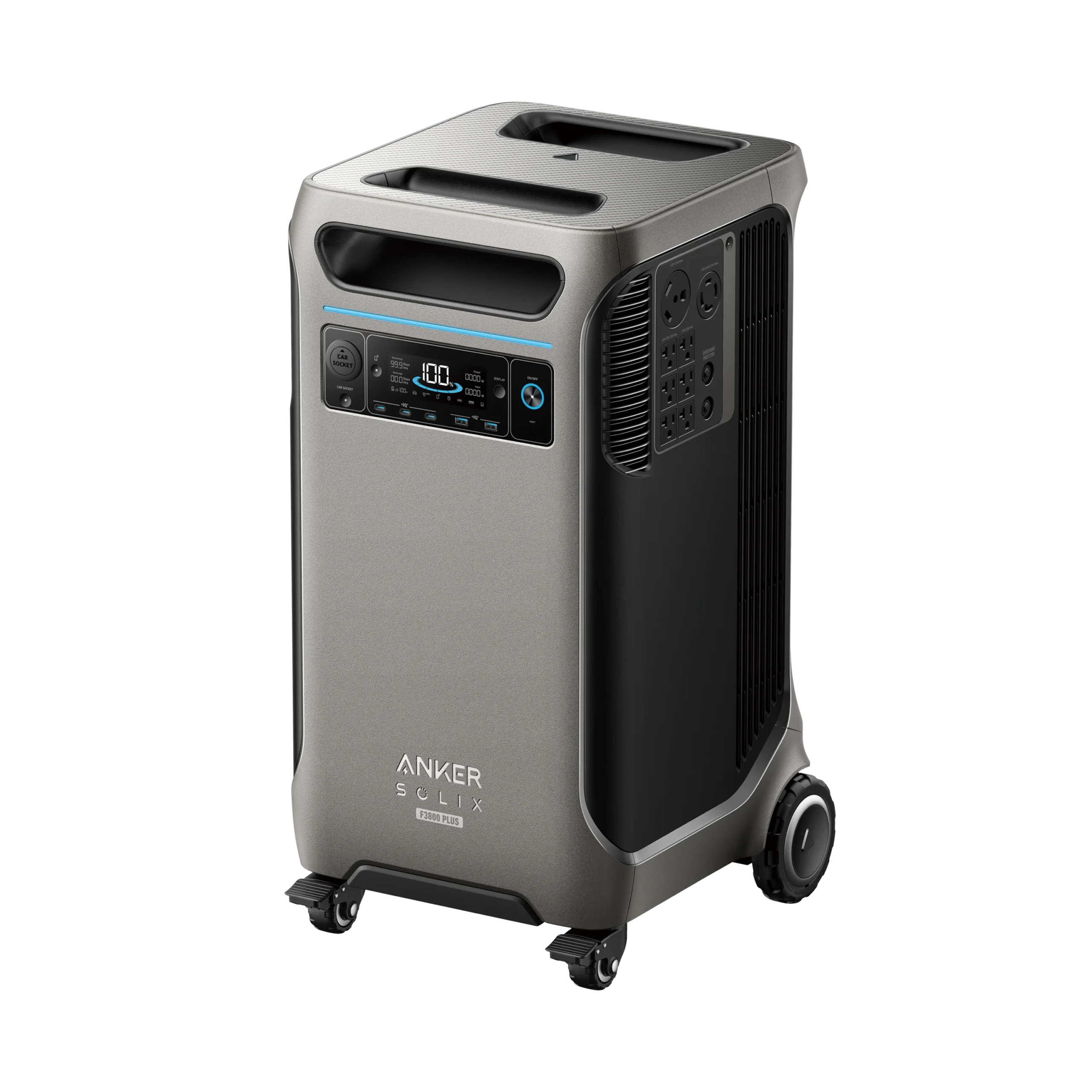
Model Tested: F3800 Plus (with Solar)
Charge Time: Depends on input
Output: 6000W
Ports: Multiple AC, USB-A, USB-C, Car Charger, more
Weight: 136.7 lbs
Pros: Surprisingly easy to move, very solid, excellent output and features for price
Cons: Overkill for most, can be pricey to outfit with full solar setup
Let’s say the quiet part out loud: Most folks do not need a power station with the capacity and output of the Anker SOLIX F3800 Plus. But if you do want a high-output home backup solution, we haven’t tested any better, especially considering that the price often hovers just over $2000 (and often less on sale). The customizability and complete feature set make this our favorite large-capacity unit for powering an off-grid cabin, backing up the home in an emergency, or setting up one sweet tailgate.
At nearly 150 pounds, the F3800 Plus tests the limits of “portable” when it comes to power stations, yet we were pleasantly surprised with how easy this is to roll around. The handle feels more solid and the wheels roll more smoothly than the Jackery Explorer 2000 Plus below. Using this power station wasn’t as scary as it might seem—the useful screen paired with the app made it easy to adjust settings and track power. Oh, and have we mentioned the output? At 6000 Watts, you can truly backup an entire home, or at the very least the appliances and essentials that you need, should the power go out for a long period of time.
We highly recommend pairing this with a high-capacity solar setup, as we were able to keep this unit topped up for months despite consistent power use with just one of Anker’s rigid solar panels. Ideally, you never have to use a home backup power station like this, but if you need one, the Anker SOLIX F3800 Plus is far and away our favorite.
Check Price on Anker Check Price on Amazon
Best Portable Power Bank for Travel
Anker 737 ($150)
Models Available (in mAh): 24,000
Model Tested: 737
Charge Time: Depends on the cord you use – as low as 40 minutes
Output: 250W
Ports: Input: USB C, Output: USB A and C
Weight: 1.4 lb
Pros: Compact, easy to read display, can take on a plane
Cons: Recharge time can be slow without the right cable
Being able to charge on the go is a big deal, but air regulations prohibit transporting any battery over 27,027 mAh (or 100Wh). The Anker folks knew this and developed a charging unit that just squeaks under the limit at 24,000 mAh. This allows travelers to Instagram to their heart’s content without fear of running out of juice right at sunset. Most smartphones can get 5 charges on this, and we could recharge an entire 14-inch Macbook Pro once, and in under an hour, thanks to its 250W output.
It’s by no means a full-blown power station and doesn’t really compete with the others on this list, but sometimes you just need to power some USB devices and don’t have the capacity to carry around a larger/heavier unit. For those instances, we were happy with the portability and simplicity of the 737. It has a digital readout of power consumption to keep you on track, something other smaller-scale power banks usually lack. At just over a pound, we’d happily take this along for short camping trips where we just want to keep phones and headlamps charged.
Best Compact Power Station for Car Camping
EcoFlow River 3 ($189)
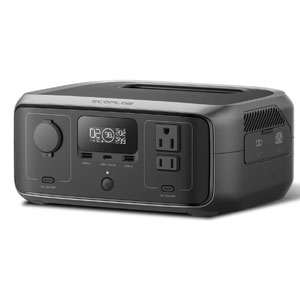
Models Available (in Wh): River 3, River 3 Plus, River 3 Max
Models Tested: River 3
Charge Time: 1 hr (AC)
Output: 300W (600W Peak)
Ports: Input: DC/AC Output: 1 DC, 1 USB C, 2 USB A, 2 AC
Weight: 7.8 lbs
Pros: Extremely portable, perfect size and capacity for quick trips, good peak output for a small unit
Cons: Not particularly versatile for larger needs
We were stoked to get our hands on an early sample of the EcoFlow River 3, and it did not disappoint. An updated and smaller sibling to the top pick EcoFlow River 2 Pro, the River 3 is an extremely capable compact portable power station that’s perfect for quick camping trips or powering small devices on the go. We loved it for a mobile office out at cafes (keeping camera gear and laptops charged is critical in our work), and it functions perfectly as a phone, flashlight, and other small device charger at camp with friends.
Some of the standout features include an extremely fast charge time; it only takes an hour to get this fully charged thanks to the 320-watt input. Plus, the 300-watt continuous or 600-watt peak output is seriously impressive for a unit of this size (245-watt capacity). Speaking of size, this power station is just 7.8 pounds and 10 inches by 8.3 inches by 4.4 inches—talk about portable! This is now our go-to power station for most weekend car camping trips, as it has just the right blend of capacity and size.
The only drawback we can really note is that this portable power station is for a very specific audience. It’s a little too big and heavy to be a truly portable option (think backpacking or long photo/video hikes), but it’s not quite big enough for a longer trip or for extensive device charging. That said, we absolutely loved this power station for weekend camping trips—it’s great to stash in a tent to top up phones and flashlights while not needing to haul a hefty unit to and from camp. Plus, it’s really competitively priced.
Best of the Rest
Another Great Home Backup Option
Jackery Explorer 2000 Plus ($2199)

Models Available (in Wh): 2000 Plus, 1000 Plus, 700 Plus, 300 Plus
Models Tested: Explorer 2000 Plus (and additional 2000Wh Battery Pack)
Charge Time: 2 hours
Output: 3000W (6000W Peak)
Ports: 2 x USB-A Output, 2 x USB-C Output, AC Output (25 amp), 4 x AC Output (2o amp), AC Inputs, DC Input, Car Port
Weight: 61.5 lbs
Pros: Huge power output and capacity, expandable, much longer cycle life than competitors (even other Jackery models)
Cons: Cumbersome and heavy, pull-handle isn’t the best quality
If you need your portable power station to support days of off-grid adventure (and maybe backup your home power), check out the Jackery Explorer 2000 Plus. This power station is one of our favorite heavy-duty options due to its impressive output (3000W max and 6000W peak) and expandable capacity (up to a whopping 24kWh). We tested the 2000 Plus with an additional 2000Wh Battery Pack, which we found made an exceptionally powerful package that — thanks to the built-in wheels and pull handle — was still able to be transported (though, at about 100 pounds combined, this setup is heavy). We gave the home backup edge to the Anker F3800 above, but this is a worthy competitor.
Jackery’s Plus series is a step up from their already excellent Pro series, and indicates portable power stations that are not only expandable but also have a much more durable battery setup. The Plus series power stations have batteries that can go through anywhere from 3000 to 4000 charge cycles, depending on size. That’s a huge increase over some models in this list, including other Jackery power stations. On one extended car camping trip, one of our testers ran his Dometic CFX3 75DZ portable fridge for two weeks using just the Explorer 2000 Plus (sans additional battery). That was in addition to powering phones, lanterns, laptops, and headlamps. While he kept the power station topped up using the car and solar charging, not once did the Jackery get near depletion.
The other reason we love the Jackery 2000 Plus as a high-capacity portable power station is that it features wheels and a telescoping handle to help transport the admittedly heavy unit (61.5 pounds). While we felt the handle could have been of better quality, the wheels rolled smoothly over hard-packed terrain. Big, built-in grab handles make it easier to load into the car. And beyond the high capacity, we also felt like this Jackery model had an appropriate number and variety of outputs to be useful on adventures. While this big unit isn’t for everyone, if you need loads of capacity and a high peak output, the Jackery 2000 Plus is a good bet.
Check Price on Jackery Check Price on Amazon
Another Great Compact Option
FJD Pony 500 ($299)
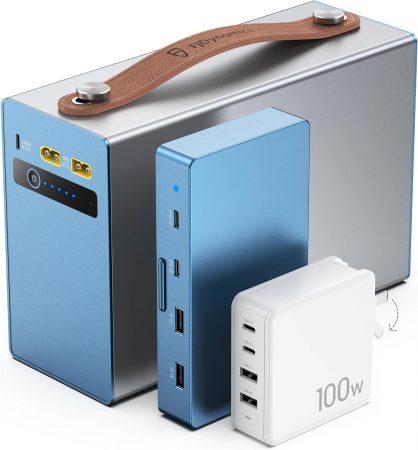
Models Available (in Wh): 504
Charge Time: 4-5 hours
Output: 140 W
Ports: Input: USB C and 58V XT 60 DC (Solar), 3 USB-C, 2 USB-A, 2 XT 60
Weight: 7.9 Lbs
Pros: Ultra-compact, retro design, no noise
Cons: No AC port or display, long charge time
For those who don’t need an AC plug and only require some reliable, quiet, and compact USB power, we are huge fans of the Pony 500 from FJ Dynamics. By not having any bells and whistles, it’s able to come in a much smaller package than others.
The unit also allows input/output via 2 XT ports, which are most commonly used on other power stations for input from a solar panel. It’s important to note these XT ports can’t take more than 48V — a mistake we made by blowing out one of the ports when trying to charge via a solar panel. That’s more our fault as they did have the warning in the manual. So: Now you’ve been warned too.
The Pony 500 uses NMC chemistry rather than LiPo, which has advantages and disadvantages. The main advantage is energy density — you get more watt-hours per pound with NMC. The technology can also lead to greater operating temperature ranges. In this case the FJD Pony 500s range is from -4 to 140 degrees Fahrenheit (look out, Jackery Explorer 500).
Overall, this super-compact and portable power station is great for powering up small devices, though it does run a bit pricey for its versatility.
Anker Powerhouse 535 ($500)
Models Available (in Wh): 256, 512, 1229, 2048
Model Tested: PowerHouse 535 (512 Wh)
Charge Time: 2.5 hours to 80% (Using AC and USB C together)
Output:500W
Ports: Input: AC and USB C, Output: 4 AC (500W shared), 3 USB A, 1 USB C, 1 DC (120W)
Weight: 16.8 lbs
Pros: Switching to recycled and bio-based plastic
Cons: Handle makes stacking difficult, can only use half the AC outlets for 3-prong plugs at a time
Anker was founded by a former Google employee who wanted to make better batteries for laptops. Since then, the company has created an array of power supply solutions and accessories. One of their latest innovations is the Powerhouse line of power stations, and they continue to provide reliable power on the go.
With a huge array of ports, the Anker Powerhouse 535 is a great option if you have a lot of small devices between several people. We loved the light bar on the side, as it functioned like a lantern and helped illuminate the unit when we needed to use it at night. It’s rated to hold up for 3000 cycles, so it has great value that will last many years down the road. A major downside is that even though there are four AC outlets, you can only use two of them at a time if you have devices that require a ground prong. That said, the Anker Powerhouse is a simple and versatile portable power station.
GoalZero Yeti 500 ($500)
Models Available (Wh): 505, 983, 1516, 3032, 6071
Model Tested: Yeti 500 ( 505 Wh)
Charge Time: 6+ hours
Output: 300W, 1200W peak
Ports: 2x USB A, 1 USB C, 1USB C pd (input/output), 2x 120V AC
Weight: 12.9 lbs
Pros: Small and portable, solid reputation
Cons: Charge time from the wall was significantly longer than other models
GoalZero is an O.G. of the portable power station scene. The brand has been doing it for much longer than many others in this guide and has a range of products showcasing its experience in this field. That track record alone is worthy of attention.
The Yeti 500 is one of the the lightest and most compact 500Wh units in this guide and allows for easy stacking if wanting to join forces with other units. Having inputs on both sides also provides plenty of flexibility while charging in potentially cramped situations. The interface is sleek and easy to read, and it is the only power station we tested that allows you to cycle through different units, such as volts and amps, for those with some electrical curiosity.
Everything about this power station was great, although it’s worth noting that the charge time using the wall adapter was significantly higher than that of other units in its class. This portable power station does have solar charging capability, but to keep things consistent for our testing, we measured input from the wall. It took well over 6 hours to get a full charge. Also worth noting — the device is rated to 500 charge cycles, whereas some other brands in this review boast up to 6x the amount. But if portability is your main need, you can’t go wrong with the sleek design.
As a side note, the name “Goal Zero” comes from the brand’s mission to help eradicate poverty by bringing sustainable power solutions to rural villages in developing countries: a noble cause, indeed. The brand is also the only company in our review to be born and bred in the USA.
BioLite BaseCharge 600 ($560)
Models Available: 622Wh, 1521Wh
Model Tested: Basecharge 600 (622Wh)
Charge Time: 7 hours to 80% (AC) 3.5 hr (AC + USB C)
Output: 600W, 1000W Surge
Ports: 4 AC, 2 USB-A, 2 USB-C, 3 DC out, DC in (solar)
Weight: 14 lbs
Pros: Clean design, wireless phone charging on the top deck
Cons: Side handles make carrying it with other stuff awkward, slow charging
BioLite makes much more than power stations, from fire pits to camp stoves. But the brand sees the future in combustion-free power and has developed two portable power stations plus the solar panels to charge them. While not having as many models as the competition, BioLite’s two offerings are crowd-pleasing, functional models powerful enough to handle most people’s needs.
The BaseCharge 600 was light and easy to carry, however the side handles made it awkward to grab with one hand, especially if you are loading up with other gear. It was also only one of two models tested that has wireless charging on the top deck — great for adding juice to the phone in a pinch without having to compromise a plug elsewhere. We also liked that you could see and reset the watt-hours used, a nice feature to track power consumption.
Another great feature was the DC solar panel input. That means you can use either BioLite’s own panels to charge or any other solar panel with the two-prong +- input to charge the device, a feature that only the EcoFlow devices also had. Overall, the BioLite Basecharge is an excellent portable power station for the money.
Check Price on REI Check Price on BioLite
Anker Solix C1000 ($549)
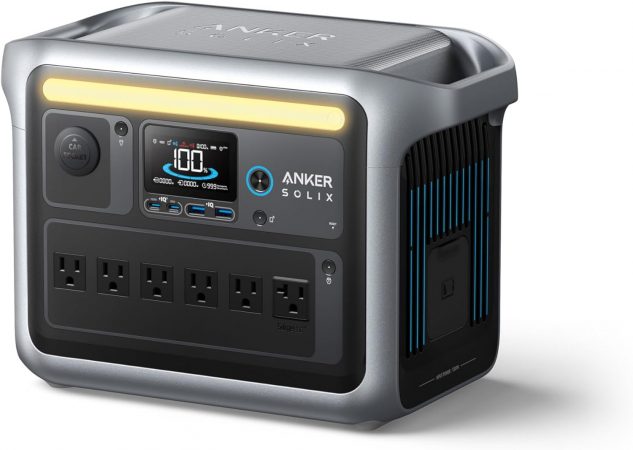
Models Available (in Wh): F1200, F2000, F2600
Model Tested: C1000 (1056 Wh)
Charge Time: Less than an hour
Output: 2000W Max
Ports: Input: AC and DC, Output: 6 AC, 2 USB A, 2 USB C, 1 DC
Weight: 26.5 lbs
Pros: 6 AC ports, super fast charging time
Cons: Heavy for weekend/camping use
Anker’s Solix line of portable power stations is a major upgrade over previous offerings. We felt the 1000Wh unit with lightning-fast charging (under an hour with AC power) and numerous ports was a versatile beast.
This is a power station that should be more than enough on a camping trip but can also serve as a home backup or for a remote worksite or film shoot. It’s a great option for situations where you’re worried about running out of power, and if you have the space and two hands to port it around, it’ll suit you well. We enjoyed being able to plug in a number of devices without having to worry about having to jockey for a plug (6 AC ports!). That makes it great for use with larger electronics, like laptops, cameras, etc.
So, if you’re into glamping and want to run a blender, coffee grinder, or even a portable sound system for a few hours, this might be the power station for you. Just note — this power station is heavy at 26.5 pounds.
Dometic PLB40 ($540)
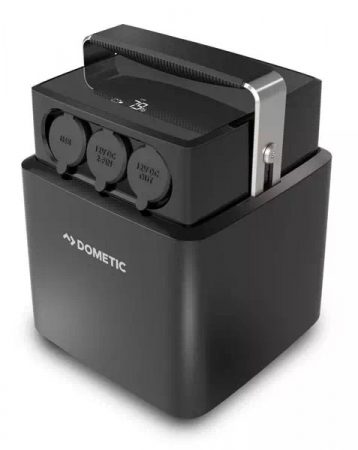 Models Available: This is the only one in the Dometic line.
Models Available: This is the only one in the Dometic line.
Model Tested: PLB40 (480Wh)
Charge Time: 6 hr to 100%, 4hr40 to 80%
Output: 180W
Ports: DC in, DC out, USB out
Weight: 16 lbs
Pros: Small size, quiet
Cons: DC Power only, need an additional inverter for AC power, not designed for direct sunlight
Dometic doesn’t really market this as a “Portable Power Station” as other companies do, but that’s a little confusing. The “PLB” in the model name stands for “Portable Lithium Battery,” which is true to its claim. The PLB40 is intended to serve as a power source for Dometic’s wide range of powered coolers, but really, it can power anything and everything one would need on a road trip or weekend away. Thanks to its sleek profile, cube-shaped design, and easy-carrying handle, it’s one of the best options for those with tight spaces like a car or an overloaded RV. In fact, it was close to half the size of comparable models. Is the higher price tag worth saving space in your tiny home or van? For many folks, absolutely.
That said, if you’re using multiple devices and can afford the extra volume of a larger power station, this wouldn’t be our first pick. The lack of output options means it’s best used for one larger device (such as a cooler/fridge), with a bonus USB output to charge a phone or other small device. The good news is that it does that job very well, so if that’s all you need, this unit is more than capable without any extra bells and whistles adding volume and weight.
Check Price on Dometic Check Price on Amazon
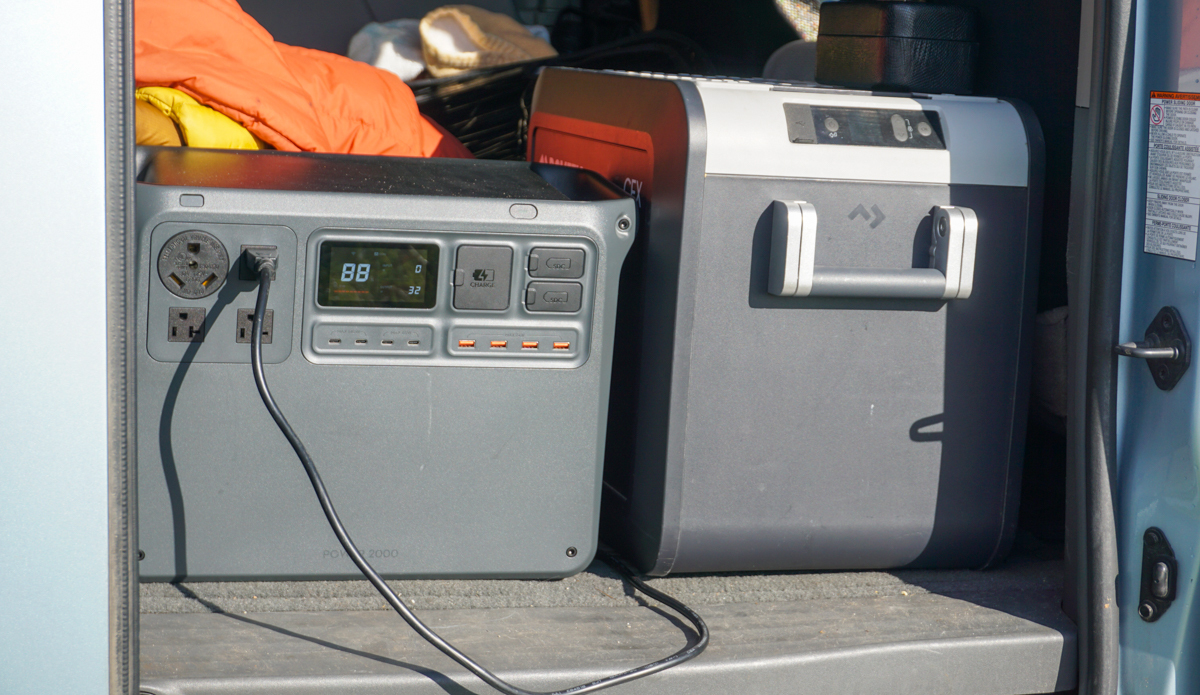
Every power station on this list was put through the paces. Photo: Will Sileo//The Inertia
Portable Power Stations Comparison Table
| Brand | Model Tested | Price | Watt-Hours | Charge Time | Charge Cycles (claimed) | Models Available (in Wh) |
| EcoFlow | River 2 Pro | $549 | 768 | 70 min | 3000 to 80% | 256, 512, 768, 2400, 3600 |
| Bluetti | AC70 | $399 | 768 | 70 min | 3000 to 80% | 204, 403, 768, 1,152, 2,043 |
| DJI | Power 2000 | $999 | 2048 | 90 min | 4000 | 512, 1024, 2048 |
| Anker | F3800 Plus | $2394 | 3800 | Depends on input | 3000 | Expandable |
| Anker | 737 | $150 | 99.54 | 40 min | 300-500 | 99.54 |
| EcoFlow | River 3 | $179 | 245 | 1 hr | 3000 | River 3 Plus, River 3 Max |
| Jackery | Explorer 2000 Plus | $2199 | 2042 | 2 hr | 4000 to 70% | 2000 Plus, 1000 Plus, 700 Plus, 300 Plus |
| FJD | Pony 500 | $299 | 503 | 5 hr | 2500 | 503 |
| Anker | Powerhouse 535 | $500 | 512 | 3.5 hr | 3000 | 256, 512, 1229, 2048 |
| GoalZero | Yeti500x | $500 | 505 | 6+ hr | 500 to 80% | 505, 983, 1516, 3032, 6071 |
| BioLite | BaseCharge 600 | $560 | 622 | 7 hr (AC), 3.5 hr (AC + USB-C) | 1000 at 80 % | 622, 1521 |
| Anker Solix | Solix C1000 | $999 | 1056 | 45 min | 3000 | 1056, 1229, 2048, 2560 |
| Dometic | PLB40 | $549 | 480 | 4:40 hr to 80% | 2000 | 480 |

A compact power station is great for charging phones, speakers, and cameras. Photo: Nathan Lemin//The Inertia
How We Tested Portable Power Stations
Steve Andrews and Nathan Lemin spearheaded the testing of portable power stations. We charged a range of everyday devices off the smaller models: a phone and a laptop, drone batteries, flashlights and headlamps, and fans. For the larger models, we cranked up a Vitamix blender to see how it could hold up, as well as charged an e-bike battery. All the units were fairly true to their specs on power capacity, and the displays were accurate.
Where we found differences was in time to charge, total claimed battery cycles, portability, number of inputs and outputs, and other small design features. Most of the larger units have a cooling fan to keep the temperature down when the wattage is high, which will also effect how much power it’s consuming beyond powering any particular device. The higher the wattage being used, the more the fan will be necessary.
Charge time is a fairly objective measurement; it’s easy enough to record how long it takes to reach a full battery (we charged all our units from the same outlet). Other factors, such as portability, are subjective in that we measured how easy the handle is designed for moving the power station amongst other gear, and how well it packs into a storage bin when on the go.
Weight is also a factor, and the lighter units were favorable for obvious reasons. For charging cycles, we had to take the manufacturer’s word for it, as charging and discharging for up to 3000 cycles (as EcoFlow claims) is next to impossible amongst all of life’s other demands.
On the input/output side, some brands (such as EcoFlow) had plenty to choose from, while others (Dometic and Jackery) were more limited. That’s not to say those models don’t have good use cases.
The other factor we included was whether or not the devices came with an app to control and monitor the power input and output, and how user-friendly it is. That info is noted in the descriptions for the respective companies.
In our original testing, we did our best to standardize the guide by using portable power stations around the 500Wh range (with a few exceptions based on availability). In our updates, we broadened our testing pool to include portable power stations of varying sizes (from 99.54Wh to well over 2000Wh), focusing on models that performed best in their respective categories.

Charging up some essentials at the off-grid office. Photo: Steve Andrews//The Inertia
Portable Power Stations Buyer’s Guide
Portable power stations have become a staple for outdoor enthusiasts, remote workers, and anyone needing reliable power on the go. They’re the perfect companion for car-camping trips, tailgating, power outages, or simply charging your devices when there’s no outlet nearby. Let’s dive into understanding how they work and what you should consider when shopping for the best portable power stations.
Watts, Watt-Hours, Voltage, and Amps
Before we delve into specifics, let’s clarify a few concepts. Think of electricity as water flowing through a pipe. The water’s volume (electricity amount) is analogous to Amps, the pressure (energy level) equates to Voltage, and the flow rate (power) equates to Watts. Finally, the total amount of water that has flowed over time (energy over time) is akin to Watt-Hours.

A fast charge time, easy portability, and a battery that’s 50% larger capacity than models of similar size and shape were enough for us to give EcoFlow’s River 2 Pro the nod for the Best Overall Portable Power Station. Photo: Steve Andrews//The Inertia
What is a Watt-Hour?
Energy comes in many forms throughout our daily lives. We even create energy just by being alive. But to measure capacity and what these portable power stations are capable of offering, we use the unit watt-hours (Wh) to have a standard that is easy to communicate. But what exactly is a watt-hour?
Let’s use the metaphor of hiking. Imagine our watt-hour is a mountain. Everyone will reach the summit at a different pace. Some people will sprint up and be there in a half hour, while others might take a more casual pace and take half a day. If you think of energy output at any given moment in watts, you have to expend a lot more energy to go fast, but it will require less time to do so. The same goes for these power stations — a 50 W device can run for 10 hours on a 500 Wh battery. But a 100 W device will only run for five hours on the same battery. You can mix and match any amount of wattage, and the capacity (Wh) divided by the total watts will tell you how long that battery can run on one charge.
So how does this shake out for consumers? The watt-hour is our best measure of a portable power device’s capacity and translates (roughly) to certain dimensions, prices, and how big of an external device you’ll be able to power/charge. Portable power stations that have a 500 Wh capacity (or something similar) are about the size of 4-5 laptops, weigh about 12-15 pounds, and can usually charge devices as large as a portable fridge or CPAP device. Power stations with a 1000 Wh capacity can power devices as powerful as a full-sized fridge or microwave, are about the size of a small microwave, and weigh around 30 pounds.

The handle on the Jackery Explorer 500 power station makes for easy grab-and-go portability. Photo: Lindsay Gough//The Inertia
Portable Power Station Battery Chemistry: A Primer
Each of the power stations uses lithium as the primary ingredient for the rechargeable batteries. However, there are slightly different variations in the chemistry with different effects. It can seem confusing, but don’t worry: we broke it down for you.
Lithium-ion (Li-ion)
These batteries use lithium ions as their primary component. During discharge, lithium ions move from the negative electrode to the positive electrode. The reverse occurs during charging. Li-ion batteries have high energy density, little memory effect, and only a slow loss of charge when not in use. However, they can have safety concerns if not properly managed, as they may overheat and potentially explode — which is why batteries over 100 Wh aren’t allowed on airplanes.
Lithium Iron Phosphate (LFP)
This is a specific type of lithium-ion battery that uses lithium iron phosphate (LiFePO4) as the cathode material. The advantages of LFP batteries include good thermal stability, safety features, long cycle life, and a lack of any expensive or toxic metals. The energy density is somewhat lower compared to other lithium-ion chemistries, and the voltage is also lower, but they are widely used in applications where safety and lifecycle are more critical than energy density and initial cost.
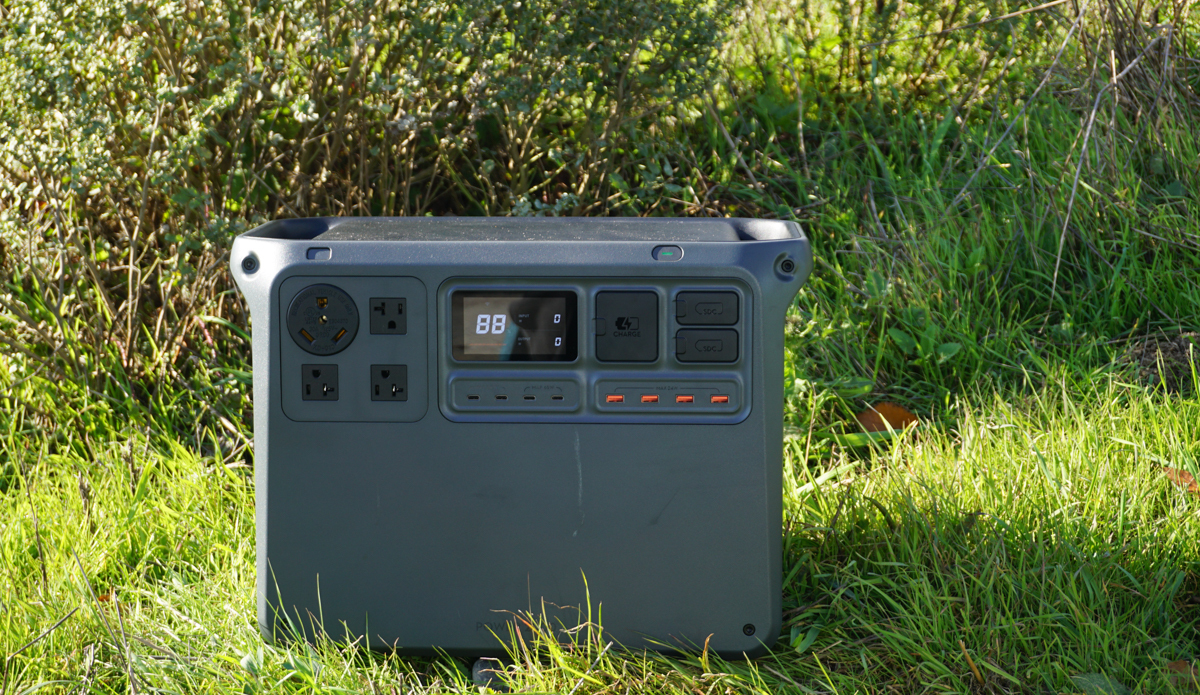
The DJI Power 2000 was a versatile and powerful unit. Photo: Will Sileo//The Inertia
Lithium Polymer (Li-Po)
These lithium-ion batteries use a polymer electrolyte instead of a liquid one. Li-Po batteries can be made thinner and lighter and can be manufactured in different shapes and sizes. They also generally provide higher specific energy (more capacity for the same size) but can have shorter lifespans and less stable chemistry, potentially leading to safety issues if damaged, improperly charged, and improperly discharged.
Nickel Manganese Cobalt (NMC)
NMC batteries are a type of lithium-ion battery characterized by the inclusion of three metals in the cathode: nickel, manganese, and cobalt. They typically have a higher energy density than other lithium-ion types, meaning they can store more energy for their size or weight. This makes them ideal for applications where size and weight are crucial factors, such as in electric vehicles and portable electronics. NMC batteries also offer good thermal stability and long cycle life, although they can be more expensive due to the cost of cobalt. Overall, NMC batteries are favored for their balance between energy density, power, and safety.

Anker’s 737 power bank has enough juice to charge a Macbook pro in just under an hour. Photo: Steve Andrews // The Inertia
What to Consider When Shopping for Portable Power Stations
The factors to consider include the power station’s capacity, its power output, the number and type of ports it has, its size and weight, and the type of battery it uses.
Power Station’s Capacity and Output
The capacity (measured in Wh) indicates how much energy a power station can store, while the output (measured in W) determines how much power it can deliver at a time. In essence, capacity dictates how long a power station can power your devices, while output determines what devices it can power.
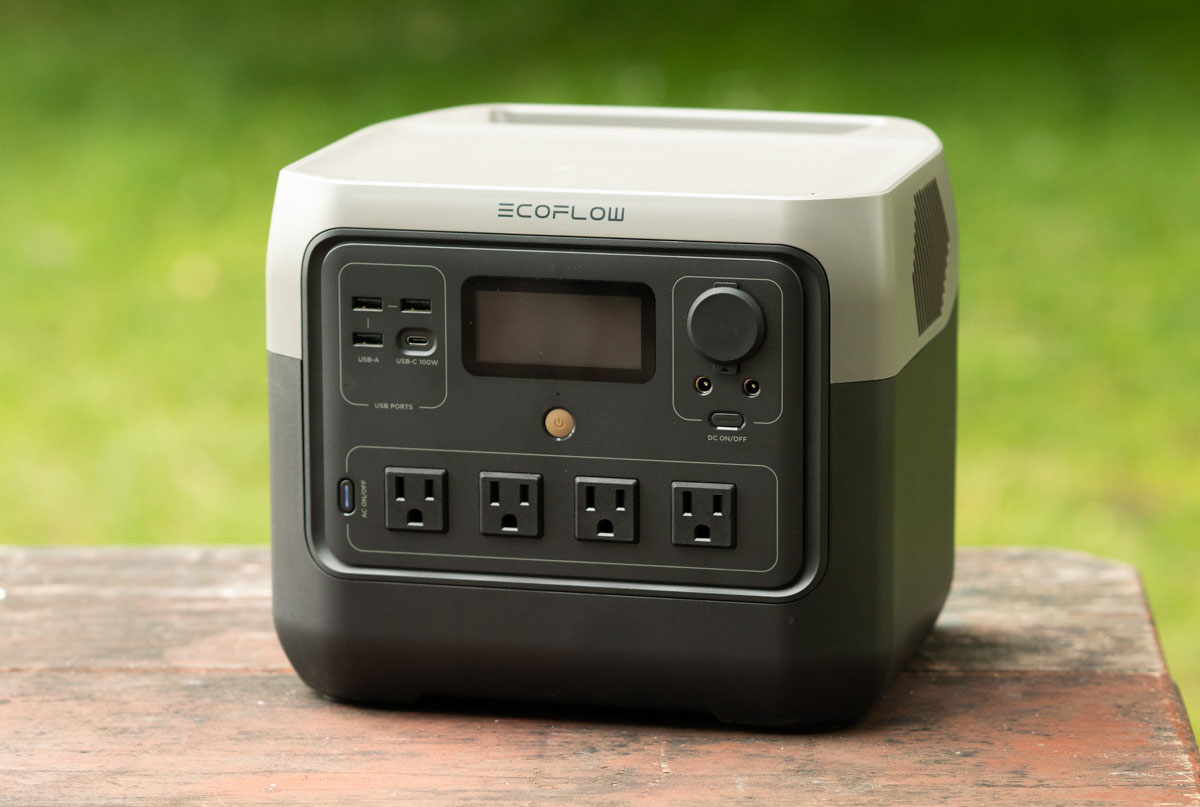
The EcoFlow River 2 Pro has the best combo of available ports, fast charging time, and guarantees up to 3000 charge cycles to 80%. It’s our pick for the best all-around portable power station.
Price: $549
Number and Type of Ports
Look for a power station with the types of ports you need. This could include AC outlets, USB ports, DC ports, and more. Also, consider how many ports it has — can it charge all your devices simultaneously? Some models also include wireless phone charging, which can be nice if you’re the type of person who tends to misplace phone cables (we’re including ourselves here).
Size and Weight
Consider your use case. If you’re going camping or want to maintain your electronic-heavy lifestyle, a compact and lightweight power station is your best bet. But you might sacrifice capacity and durability as a result. If it’s for home backup power and it’s not moving much, then extras like a big handle or wheels won’t be as much of a deciding factor.
Type of Battery
Most power stations use lithium-ion or lithium-polymer batteries because they’re lightweight, compact, and efficient. However, some models use lead-acid batteries, which can be bulkier but also cheaper. We didn’t test any lead-acid batteries, so we can’t comment on them. See our explanation of batteries (above) for more on choosing portable power stations based on battery type.

The GoalZero Yeti 500x power station and Nomad 100 solar panel make a seamless pair for renewable power. Photo: Steve Andrews//The Inertia
What is Surge Output Wattage?
Surge output wattage or peak power is the maximum power output that a portable power station can produce, but only for a very short period — usually a few seconds or minutes. It’s akin to the power station’s adrenaline rush, giving an extra boost when needed.
Why is Surge Output Wattage Important?
Certain devices, particularly those with electric motors like a fridge, a drill, or a blender, require a surge of power when they start up — much more than they need for their regular operation. This initial power draw, often referred to as “inrush current,” can be several times higher than the device’s rated power requirement.
When comparing different portable power stations, keep in mind the type of devices you plan to power. For small electronics like phones, tablets, or laptops, the continuous wattage (the power a portable power station can deliver consistently) is usually more than sufficient. However, if you intend to use devices with electric motors, make sure to check that the station’s surge output wattage can handle the startup power draw of those devices.
Bigger isn’t always better. A higher surge output wattage often means a more expensive, larger, and heavier power station. So, choose a station that fits your needs — providing enough surge output for your devices without excess.
Understanding surge output wattage is an essential part of finding the perfect portable power station. By taking this into account, you can ensure a seamless power supply for all your devices, from the smallest smartphone to the largest refrigerator, giving you the freedom and flexibility to explore, create, and live your life unplugged.

Running a fan all weekend in a hot tent is much easier when you have a portable power station. Photo: Steve Andrews//The Inertia
Power Consumption Rates: Estimating Runtime for Your Devices
It’s crucial to understand how much power your devices consume to ensure your power station can accommodate your needs. Here are a few common devices and appliances to help you understand what a 500 Wh battery can provide in terms of running time if it needs to be plugged in or charge cycles if it’s something with a battery to charge.
Phones
The iPhone 14 has an estimated battery capacity of about 12.7 Wh
With a 500 Wh power station, you could theoretically charge the iPhone 14 about 40 times (500 Wh / 12.7 Wh = 39.3 times).
Action Cams
The GoPro Hero 11 has a 4.4 Wh battery.
Using a 500 Wh power station, you could theoretically charge the GoPro Hero 9 approximately 93 times (500 Wh / 4.4 Wh = 113.6 times).
Larger Cameras
The Sony A7iii has a battery capacity of approximately 16.4Wh.
With a 500 Wh power station, you could theoretically charge the Sony A7iii around 30 times (500 Wh / 16.4 Wh = 30 times).
Bluetooth Speaker
The Bose SoundLink Revolve, a medium-sized Bluetooth speaker, has a battery capacity of approximately 7.4 Wh.
With a 500 Wh power station, you could theoretically charge the speaker about 67 times (500 Wh / 7.4 Wh = 67 times).
Power Tools
A typical Dewalt cordless drill uses a 20 V battery with a 1.5 Ah capacity, which equates to around 30 Wh (Voltage x Ampere-hours = Watt-hours).
With a 500 Wh power station, this equates to a possible 16 charges (500 Wh / 30 Wh = 16 times).
Laptop
A MacBook Pro 15-inch has an approximate battery capacity of 83.6 Wh.
With a 500 Wh power station, this means theoretically charging 6 times (500 Wh / 83.6 Wh = 6 times).
Satellite Internet
The consensus seems to be around 50-75 watts on average for the Starlink hardware, which includes both the dish and router.
With a 500 Wh battery, the Starlink Satellite could run for approximately 6.6-10 hours 500 Wh / 50-75 watts).
This is also an approximation, and if you’re using the internet all the time with multiple devices, the power consumption rate could be far greater.
Keep in mind that these are simply rough estimates. Actual power consumption will vary with different factors, such as device settings, temperature, and usage patterns. Also, the power station’s efficiency can affect the actual runtime. A more efficient power station will provide more effective power, enabling longer device runtimes.

The Bluetti AC70 has individual AC and DC input and output wattage to help you monitor use. We ran a Starlink satellite and charged several devices all day with power to spare. Photo: Steve Andrews//The Inertia
Power Efficiency
Determining the efficiency of a portable power station involves a bit of technical know-how, but don’t worry — it’s not as complicated as it sounds. Essentially, power station efficiency refers to how well a power station converts the energy stored in its battery into usable electrical power.
Efficiency and Energy Conversion
Power stations, like other electrical devices, can’t convert 100% of their stored energy into usable power—there are always losses due to factors like heat generation, internal resistance, and the energy required to run the station’s own electronic components. This means that a power station’s actual output capacity might be lower than its stated battery capacity.
For instance, let’s say you have a 500Wh power station. If it has an efficiency of 85%, the maximum energy it can deliver to your devices is actually 425Wh (500Wh x 85%).
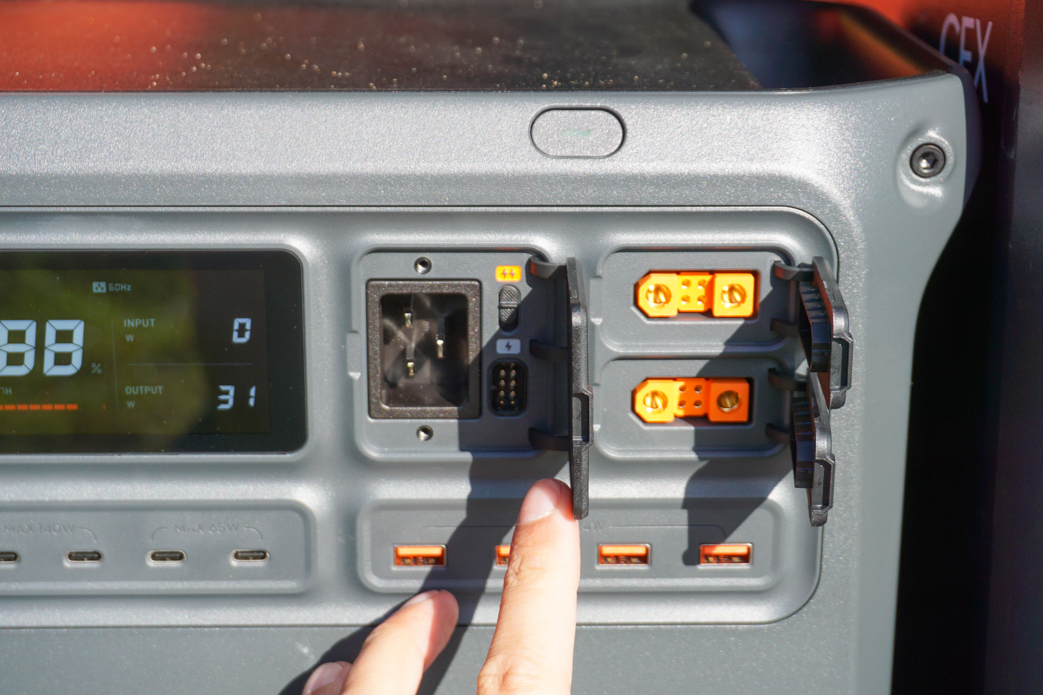
Ports, screens, features—these all contribute to how we rated power stations. Photo: Will Sileo//The Inertia
How Do I Find Out the Efficiency of a Power Station?
Manufacturers often state the efficiency of their power stations in the product specifications or manual. If not directly specified, they might provide a “conversion efficiency” or “inverter efficiency” figure, which essentially serves the same purpose.
If the manufacturer doesn’t provide an efficiency figure, you can calculate a rough estimate by fully charging the power station, running a device from it until the station is depleted, and then comparing the energy the device used to the power station’s stated battery capacity.
However, keep in mind that this method can be inaccurate due to various factors, such as the device’s power draw, the power station’s discharge rate, and the environmental conditions.
Power Efficiency: The Bigger Picture
While efficiency is an important factor, it’s only one piece of the puzzle when choosing a portable power station. Other factors like power output, battery capacity, portability, and the type and number of ports are also crucial. In the end, a power station is only as good as how well it fits your specific needs.
While the world of portable power stations can seem a bit complex at first, understanding key concepts like efficiency can help you make informed decisions, ensuring that you get the most out of your portable power station. After all, the ultimate goal is to empower you to live life to the fullest, with reliable power always at your fingertips.

With its ultra-portable design that packs a punch, the FJD Pony 500 is one of our top picks if you don’t need an AC plug. Photo: Steve Andrews//The Inertia
Other Portable Power Station Features Worth Considering
We’ve discussed a lot about portable power stations — capacity, output, efficiency, device power consumption, and more. However, a few other factors could be important to you, depending on your specific needs and circumstances. Here are a few additional considerations to round out your checklist.
Charging Options
Check the power station’s recharging options. Can it only be charged from a wall outlet, or does it also support solar charging or car charging? Multiple charging options can provide more flexibility, especially if you’re going to use the station for camping or emergencies. Also, different power sources can take different amounts of time to charge. Sometimes, a power station will allow multiple inputs simultaneously for an even faster charging time. Where the technology currently stands, wall outlet charging is the speediest option if you have access to an AC power source.
Environment and Temperature Range
Most power stations are designed for use in a fairly wide range of temperatures, but performance can decrease in very cold or very hot conditions. If you plan to use the station in extreme weather, check the manufacturer’s temperature recommendations.
Safety Features
Look for safety features such as overcharge protection, short circuit protection, and temperature control. These features can protect both your power station and the devices you’re powering.
Noise Level
Some power stations have built-in fans for cooling, which can produce noise. If you’re sensitive to noise or plan to use the station while sleeping (for example, while camping), check whether the station has a quiet or noiseless operation.
Display and Indicators
A clear and intuitive display can make it easier to check the portable power station’s status, such as the remaining power and input/output power. Some power stations also have indicator lights or alarms for certain conditions, like overloading or overheating.
In the end, choosing the best portable power station is all about considering your unique needs and circumstances. By taking into account these factors and those discussed earlier, you can find a power station that not only powers your devices but also enhances your experiences — whether you’re on a camping trip, working remotely, or simply want a reliable backup power source at home. So get out there and enjoy life off the grid, knowing you’ve got the power to stay connected wherever life takes you.
Editor’s Note: Also check out our Best Car Camping Gear and Best Camping Gear for Couples guides. For more gear reviews and features on The Inertia, click here.



